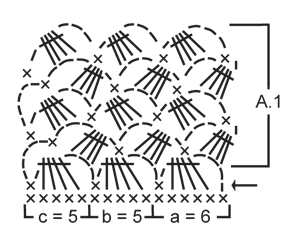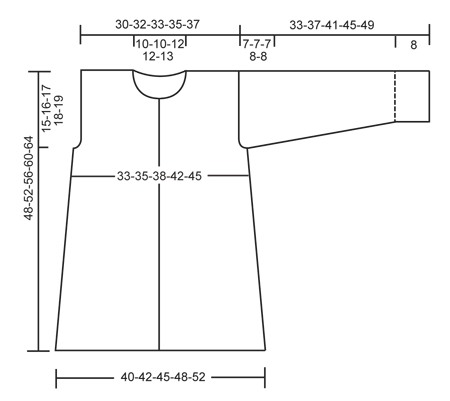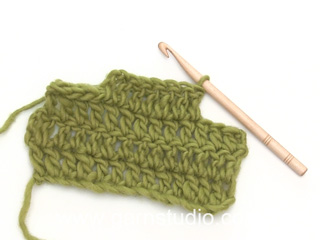Little Red Riding Hood |
||||||||||
|
|
||||||||||
Crochet coat with hood in DROPS Paris. Size children 3 - 12 years.
DROPS Children 24-37 |
||||||||||
|
CROCHET INFO: Replace first tr on row with 3 ch. PATTERN (also see diagram A.1): ROW 1 (= row marked with 1 arrow in diagram): 1 ch up from 1st dc on previous row, [3 ch, then work 4 tr tog as follows (= 1 tr-group): * Work 1 tr in next dc but wait with last pull through *, repeat from *-* 4 times in total, make a YO and pull yarn through all 5 loops on hook, 1 ch, 1 dc in next dc], repeat from [-] the entire row. Turn piece. ROW 2: 5 ch up from first dc, 1 dc at the top of first tr-group, * 3 ch, 1 tr-group in 3-ch-space on previous row, 1 ch, 1 dc at the top of next tr-group *, repeat from *-*, finish with 3 ch and 4 tr tog in last ch-space. Turn piece. ROW 3: 1 ch, 1 dc at the top of first tr-group, * 3 ch, 1 tr-group in 3-ch-space on previous row, 1 ch, 1 dc at the top of next tr-group *, repeat from *-*, work last dc on row in 5-ch-space from previous row. Turn piece. Repeat rows 2 and 3. DECREASE TIP: Dec 1 tr by working 2 tr tog as follows: Work 1 tr in first tr but wait with last pull through, work 1 tr in next tr but on last pull through, pull thread through all 3 loops on hook. Dec 2 tr by working 3 tr tog as follows: Work 1 tr in first tr but wait with last pull through, work 1 tr in next tr but wait with last pull through, work 1 tr in next tr but on last pull through, pull thread through all 4 loops on hook. -------------------------------------------------------- BACK PIECE: Work 61-63-68-73-78 ch with Paris on hook size 6 mm. Turn and work 1 tr in 4th ch from hook, continue with 1 tr in each of the next 2-4-4-4-4 ch, * skip 1 ch, 1 tr in each of the next 4 ch *, repeat from *-* the entire row = 48-50-54-58-62 tr - READ CROCHET INFO! Continue with tr upwards on all rows. REMEMBER THE CROCHET TENSION! When piece measures 15 cm, dec 1 tr in each side by working the second and third tr and the 2 next to last tr tog – SEE DECREASE TIP! Repeat dec every 5-5-6-6-7 cm 3 more times = 40-42-46-50-54 tr. When piece measures 33-36-39-42-45 cm, dec for armholes in each side as follows: Work sl sts over the first 2-2-3-4-5 tr, then work tr until 2-2-3-4-5 tr remain, turn piece. Continue with tr, there are now 36-38-40-42-44 tr on row. Continue to work until piece measures approx. 47-51-55-59-63 cm. Now work 1 row with tr only over the outermost 12-13-13-14-14 tr in each side for shoulder (the middle 12-12-14-14-16 tr = neck). Fasten off. RIGHT FRONT PIECE: Work 34-36-38-41-43 ch with Paris on hook size 6 mm. Turn and work 1 tr in 4th ch from hook, continue with 1 tr in each of the next 5-2-4-2-4 ch, * skip 1 ch, 1 tr in each of the next 4 ch *, repeat from *-* the entire row = 27-28-30-32-34 tr. Continue with tr upwards on all rows (the 3 outermost tr towards mid front = band). When piece measures 15 cm, beg dec in the side as on back piece. When dec are done, 23-24-26-28-30 tr remain on row. When piece measures 33-36-39-42-45 cm, the outermost 2-2-3-4-5 tr towards the side are no longer worked. Continue with tr over the remaining 21-22-23-24-25 tr. When piece measures 43-47-50-54-57 cm, the outermost 7-7-8-8-9 tr towards mid front are no longer worked. Then dec 1 tr towards mid front on the next 2 rows by working the 2 next to last tr towards mid front tog = 12-13-13-14-14 tr remain on shoulder. Fasten off when piece measures 48-52-56-60-64 cm. LEFT FRONT PIECE: Work as right but reversed. SLEEVE: Work 32-32-32-39-39 ch with Paris on hook size 6 mm. Turn and work 1 dc in 2nd ch from hook, then work 1 dc in each of the next 5-5-5-2-2 ch, * skip 1 ch, work 1 dc in each of the next 4 ch *, repeat from *-* the entire row = 26-26-26-31-31 dc (first ch on row does NOT count as 1 dc). Continue with PATTERN as follows - also see explanation above and diagram A.1: Diagram a over the first 6 dc, diagram b 3-3-3-4-4 times and diagram c over the last 5 dc – beg with row marked with arrow. When 5 rows of diagram have been worked, piece measures approx. 8 cm. Continue with tr as follows: 3 ch (= 1 tr), * 1 tr at the top of first tr-group, 3 tr in 3-ch-space, 1 tr in dc *, repeat from *-* the entire row but finish with 3 tr in last 3-ch-space (do not work 1 tr in last dc) = 25-25-25-30-30 tr. Continue with 1 tr in every tr upwards. AT THE SAME TIME when piece measures 10 cm, inc 1 tr in each side by working 2 tr in second and next to last tr. Repeat inc every 2nd-2nd-2nd-3rd-3rd row 3-4-5-4-5 more times = 33-35-37-40-42 tr. When piece measures 26-30-34-37-41 cm, beg dec for sleeve cap. Work sl sts over the first 3 tr, then work tr until 3 tr remain, turn piece. Work 3 ch, then work the next 3 tr tog – SEE DECREASE TIP! Work tr until 4 tr remain, work the next 3 tr tog, then 1 tr in last tr. Continue like this by working the 3 next to last tr on every row tog until piece measures 33-37-41-45-49 cm, fasten off. ASSEMBLY: Sew shoulder seams, side seams and sleeve seams edge to edge to avoid a chunky seam. Sew in the sleeves in body. HOOD: Work (from RS) approx. 30 to 40 dc around the neckline with Paris on hook size 6 mm. Turn and work dc while at the same time inc evenly (by working 2 dc in 1 dc) to 51-51-51-61-61 dc. Continue with PATTERN as follows - also see explanation above and diagram A.1: a over the first 6 dc, b until 5 dc remain and c over the last dc – beg with row marked with 1 arrow. Continue pattern until hood measures approx. 28-29-30-31-32 cm. Fasten off and sew the hood tog at the top. BAND: Work an edge around the opening on jacket, beg at the bottom on right front piece, work up and around the hood and down along left front piece. Work with Paris on hook size 6 mm: Work approx. 181-191-201-211-221 dc, no of sts should be divisible by 5 + 11. Turn piece and continue with PATTERN according to diagram A.1: A.1a over the first 6 dc, A.1b until 5 dc remain and A.1c over the last dc – beg on row marked with arrow. Fasten off when A.1 has been worked 1 time vertically. ASSEMBLY: Fasten the buttons on left front piece, the top button approx. 2 cm from neck, the bottom button approx. 8 cm from bottom edge. Place the rest of the buttons evenly between these 2 buttons. Button through band on right front piece. |
||||||||||
Diagram explanations |
||||||||||
|
||||||||||

|
||||||||||

|
||||||||||
|
Have you made this or any other of our designs? Tag your pictures in social media with #dropsdesign so we can see them! Do you need help with this pattern?You'll find tutorial videos, a Comments/Questions area and more by visiting the pattern on garnstudio.com. © 1982-2024 DROPS Design A/S. We reserve all rights. This document, including all its sub-sections, has copyrights. Read more about what you can do with our patterns at the bottom of each pattern on our site. |
||||||||||







































Comments / Questions (31)
Ich bin grade mit der Jacke fertig geworden, auf Wunsch meiner Tochter aus einer anderen Wolle, aber wir sind beide schwer verliebt in das Ergebnis. Danke für die tolle Anleitung. ♡
07.11.2023 - 14:59I don't understand how the instructions for the hood are to be worked. It says to pick up 30-40 around the neckline but if I pick up stitches around the whole neck it's much more than 40 stitches. Can I get clarification on how this part is to be worked to start the hood?
25.09.2022 - 21:16DROPS Design answered:
Dear Amy, we initially pick up less stitches (40) so that the hood won't be bulky initially. For this, we pick up stitches that are evenly spaced around the whole neckline. Later on, we will increase stitches to get the right amount to work with (51-61dc). Happy crochetting!
25.09.2022 - 22:52Tere! “ Pööra ja tee 1 sm neljandasse ahels-sse heegelnõelast, jätka tehes 1 sm igasse järgmisesse 2-4-4-4-4 ahels-sse, * jäta vahele 1 ahels, 1 ks igasse järgmisesse 4 ahels-sse*, korda *kuni* tervel real ” Ma ei saa töö algusest aru… on öeldud, et tee sm igasse järgmisesse 4 as, siis *jäta 1as vahele ja 4ks igasse järgmisesse as*…??? Mis hetkest ma ks tegema pean hakkama? Kumb siis sm või ks? Tänud juba ette abi eest?
26.02.2022 - 21:19DROPS Design answered:
Tere Liina! Viga parandatud. Sammas peab olema. Tänan teatamast! Head heegeldamist!
08.03.2022 - 22:28IK haak het jasje Little red riding hood. Achter - en voorpanden gingen prima. Ben nu met de mouwen bezig en die vind ik erg lastig. Klopt het dat de mouwen meteen al een rondje vormen?
10.02.2021 - 19:14DROPS Design answered:
Dag Femke,
Nee, de mouw wordt heen en weer genaaid en op het einde wordt de onderarmnaad dicht genaaid.
12.02.2021 - 13:19Lager to jakker str 7/8år. Ermene passer ikke i bolen. Har heklet etter oppskriften, men ermene på 41 cm er altfor små til bolen. Hva har jeg gjort galt?
28.05.2020 - 20:53DROPS Design answered:
Hei Anni. Er heklefastheten som er oppgitt i oppskriften overholdt? mvh DROPS design
03.06.2020 - 10:41No entiendo cuando dice que se realice los puntos altos 4 y se deja 1 cadena
07.07.2019 - 01:08DROPS Design answered:
Hola Ana. Si te refieres al inicio de la labor, no trabajamos puntos altos en todas las cadenetas del inicio, se trabajan 4 puntos altos y se salta 1 (se deja sin trabajar 1 punto de cadeneta) y así toda la fila. Esto se hace para que el borde de montaje no quede muy tenso.
10.07.2019 - 23:21I am working on the hood which seems to be worked along the right front, back and left front all in rows ...i'm not understanding that part at the end that says sew the hood tog at the top. if it's all connected, what am i sewing together?
31.03.2019 - 00:12DROPS Design answered:
Dear Mrs Magill, when the hood is finished, you have to fold it double to sew the last row together to close the hood (see this video with this knitted hood where the technique will be the same). Happy knitting!
01.04.2019 - 16:10I have finished the sweater except the hood and the trim around front and hood. When doing the hood how do I do the corner where the neck and front side connect
05.03.2019 - 18:05DROPS Design answered:
Dear Tereasa, start first row on hood from RS on the top corner of the right front piece, work along neckline on right front piece, then along neckline on back piece and along neckline on left front piece = you should have approx. 30 to 40 sts. Turn and adjust the number of sts on next row to 51-61 sts. You should now work from edge on right front piece to edge on left front piece (from RS and opposite from WS). Happy crocheting!
06.03.2019 - 09:10Hallo, ondertussen heb ik mijn fout gevonden en is het voorpand zoals het hoort te zijn. Gelukkig! Bedankt voor uw reactie. Groetjes
26.08.2018 - 21:34Ik ben met dit prachtige vest bezig. Alleen heb ik bij het rechtervoorpand een extra "inham" waar ik gemindert heb (tussen de mouwinzet en schouder) Klopt dit of heb ik wat mis gedaan? Groetjes
20.08.2018 - 11:19DROPS Design answered:
Dag Antje, Nee, je hebt op het rechtervoorpand geen extra 'inhammen' tov het linkervoorpand. Alle armsgaten zouden er ongeveer hetzelfde uit moeten zien. Door het minderen kan er wel enigszins een verspring in zitten omdat je in stokjes haakt, maar geen inham. Controleer het patroon nog even goed om te kijken of je niet per ongeluk een foutje gemaakt hebt.
23.08.2018 - 20:23